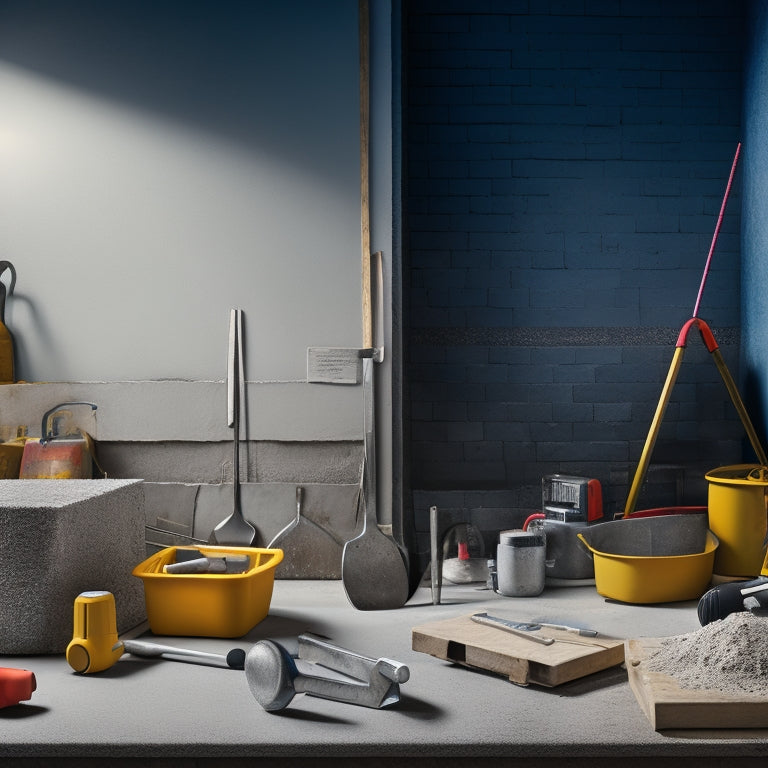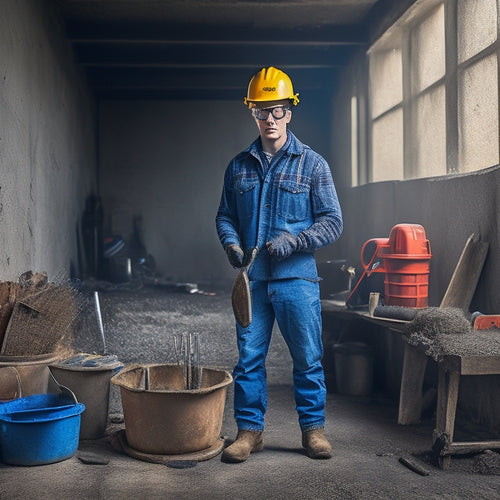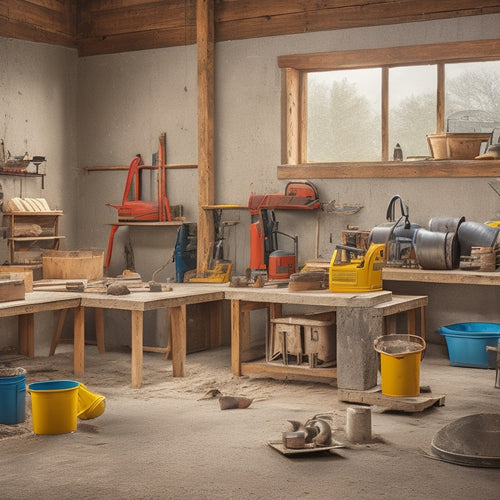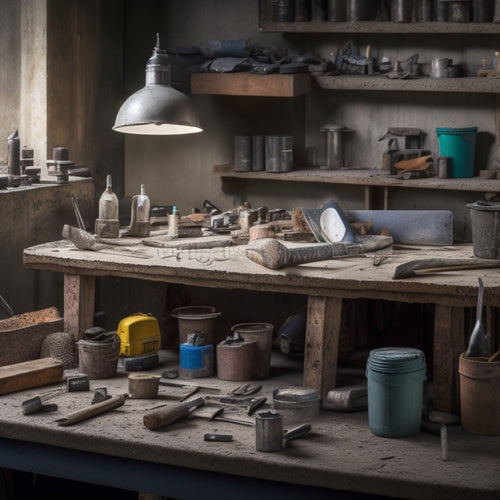
7 Best Tools for Concrete Block Wall Construction
Share
To build a strong and durable concrete block wall, you'll need a reliable set of tools. Start with essential tamping tools to make certain blocks are securely set, then use a reliable block laying trowel to achieve a durable bond. A high-quality concrete mixer bucket and efficient mortar mixing paddle will help with mixing and preparing materials. For precision cutting, invest in a durable block cutting saw, and a precise level and alignment tool will guarantee straight walls. Finally, heavy-duty block handling gloves will protect your hands during handling. By arming yourself with these seven essential tools, you'll be well on your way to a successful project, and exploring their features and benefits will reveal even more nuances to master.
Key Takeaways
• Essential tamping tools guarantee secure setting of concrete blocks, preventing settling or shifting and ensuring structural integrity.
• Reliable block laying tools, including trowels and mixing paddles, facilitate a durable bond between blocks and mortar.
• High-quality mixing tools, such as concrete mixer buckets, optimize mixing techniques and ensure consistent concrete quality.
• Durable cutting tools, including block cutting saws, enable precise cuts and reduce vibration, enhancing cutting experience and operator comfort.
• Precise alignment and handling tools, including levels and block handling gloves, ensure walls are straight, level, and plumb during construction.
Essential Tamping Tool for Blocks
You'll need a reliable tamping tool to guarantee each concrete block is securely set in place, preventing settling or shifting that could compromise the structural integrity of your wall. A sturdy tamping tool allows you to apply the necessary force to compact the mortar and guarantee block stability. This is critical, as unevenly set blocks can lead to cracks, weaknesses, and even collapse.
Mastering tamping techniques is essential to achieving a solid, long-lasting wall. You'll want to use a gentle yet firm motion to tamp each block, starting from the center and working your way outwards. This helps to evenly distribute the force and prevent air pockets from forming.
It's important to tamp each block as soon as it's laid, while the mortar is still fresh and pliable. By doing so, you'll create a strong bond between the block and the mortar, guaranteeing your wall can withstand the test of time and harsh environmental conditions.
Reliable Block Laying Trowel
Select a block laying trowel that can hold a generous amount of mortar, allowing you to spread it evenly and consistently across the block's surface.
A reliable trowel is essential for achieving a strong, durable bond between the blocks and mortar. When choosing a trowel, consider the materials used in its construction. High-quality trowels are typically made from durable materials such as stainless steel, aluminum, or high-carbon steel.
Here are some key features to look for in a block laying trowel:
-
A comfortable, ergonomic handle that reduces fatigue and provides a secure grip
-
A sturdy, rust-resistant blade that can withstand heavy use and harsh environments
-
A well-designed notch pattern that helps to hold and spread mortar evenly
- A balanced design that allows for smooth, precise movements and control
High-Quality Concrete Mixer Bucket
When you're constructing a concrete block wall, you need a high-quality concrete mixer bucket that can keep up with your demands.
You'll want to contemplate a bucket that facilitates an efficient mixing process, ensuring your concrete is consistently mixed to the right consistency.
Additionally, you'll need a bucket that's durable enough to withstand the rigors of heavy use and easy to clean to minimize downtime.
Efficient Mixing Process
Achieve a consistent and high-strength concrete mix by investing in a high-quality concrete mixer bucket that can handle large volumes of aggregate and cement while minimizing mixing time. This will enable you to optimize your mixing techniques, guaranteeing that the material ratios are precise and the concrete is of high quality.
To take your mixing process to the next level, consider the following:
-
Accurate material measurement: Confirm that you're using the correct ratio of cement to aggregate to achieve the desired strength and consistency.
-
Efficient mixing sequence: Start by mixing the dry ingredients, then gradually add water to avoid segregation and guarantee a uniform mix.
-
Optimal mixing time: Aim for a mixing time of 3-5 minutes to prevent over-mixing, which can lead to weak concrete.
- Regular bucket cleaning: Clean your mixer bucket regularly to prevent material buildup and guarantee consistent mix quality.
Bucket Durability Matters
Bucket Durability Matters
Frequently, a high-quality concrete mixer bucket outlasts its cheaper counterparts, withstanding the rigors of heavy use and harsh construction environments. You need a bucket that can keep up with your demanding workload, and a high-quality one is vital. The durability of your bucket is significant, as it directly affects the efficiency and quality of your concrete block wall construction.
When selecting a concrete mixer bucket, consider the bucket weight and material. A heavier bucket made from robust materials can handle more weight and withstand harsh conditions. Here's a comparison of different bucket materials:
| Bucket Material | Bucket Weight (lbs) | Durability Rating (1-5) | Cost Range |
|---|---|---|---|
| Steel | 50-70 | 4 | $200-$400 |
| Fiberglass | 30-50 | 3 | $150-$300 |
| Polyethylene | 20-30 | 2 | $100-$200 |
| Heavy-Duty Steel | 80-100 | 5 | $500-$800 |
Investing in a high-quality concrete mixer bucket will save you time and money in the long run. It's important to weigh the costs against the benefits and choose a bucket that meets your specific needs.
Easy Cleaning Design
A high-quality concrete mixer bucket featuring an easy cleaning design reduces downtime and increases productivity by allowing you to quickly remove residual concrete and debris.
With a well-designed bucket, you'll spend less time cleaning and more time pouring, ultimately getting the job done faster.
Here are some key features to look for in a bucket with an easy cleaning design:
-
Sloped interior surfaces: Allow concrete to flow easily out of the bucket, reducing the amount of residue left behind.
-
Rounded corners and edges: Prevent concrete from accumulating in tight spaces, making cleaning a breeze.
-
Smooth, rust-resistant coatings: Reduce the risk of concrete sticking to the bucket and make cleaning easier.
- Drainage holes: Allow water to flow out of the bucket, reducing the risk of water accumulation and making cleaning more efficient.
Durable Block Cutting Saw
When you're working with concrete blocks, a durable block cutting saw is essential for making precise cuts.
You'll want a saw that incorporates advanced cutting technology to guarantee accurate cuts every time.
Look for a saw that also prioritizes blade durability and reduced vibration handling to make your work easier and more efficient.
Precise Cutting Technology
You'll achieve precise cuts and minimize waste with a durable block cutting saw, which features a high-torque motor and diamond-coated blade designed specifically for cutting through concrete blocks. This technology allows for accurate cuts, reducing the risk of errors and guaranteeing a professional finish.
When it comes to precise cutting, a durable block cutting saw offers several benefits, including:
-
Laser cutting accuracy: The saw's precision-guided system guarantees straight cuts, reducing the need for manual adjustments.
-
Block precision: The diamond-coated blade is designed to cut through concrete blocks with ease, resulting in clean, precise cuts.
-
Reduced vibration: The high-torque motor minimizes vibration, allowing for a smoother cutting experience and reducing operator fatigue.
- Increased productivity: With precise cuts and reduced waste, you'll be able to complete projects faster and more efficiently.
Enhanced Blade Durability
The durable block cutting saw's diamond-coated blade is engineered to withstand the rigors of frequent use, its enhanced durability ensuring consistent performance and minimizing the need for frequent blade replacements. This is achieved through the use of high-quality blade materials, specifically designed to resist wear and tear.
As you cut through concrete blocks, you'll notice the saw's ability to maintain its cutting edge, even when tackling tough materials. The saw's enhanced blade durability also allows you to employ advanced cutting techniques, such as plunge cutting and bevel cutting, with confidence.
This is particularly useful when working with large concrete blocks, where precision and control are essential. By choosing the right blade materials and employing the correct cutting techniques, you'll be able to make precise cuts, reduce waste, and increase your overall productivity.
With a durable block cutting saw, you can focus on getting the job done efficiently and effectively, without worrying about blade failure or downtime.
Reduced Vibration Handling
Cutting through concrete blocks with a durable block cutting saw means less vibration handling for you, thanks to its advanced ergonomic design and strategically placed grip points. This design philosophy is centered around reducing fatigue and discomfort, allowing you to work more efficiently and effectively. By incorporating vibration dampening techniques, these saws minimize the amount of vibration transferred to your hands and arms, reducing the risk of injury and strain.
Some key features of durable block cutting saws that contribute to reduced vibration handling include:
-
Ergonomic grip design: Contoured handles and strategically placed grip points reduce slippage and provide a secure hold, even in wet or slippery conditions.
-
Vibration-dampening materials: Specialized materials and constructions are used to absorb and dissipate vibration, reducing its impact on your body.
-
Balanced weight distribution: Saws are designed to be well-balanced, reducing strain on your arms and shoulders.
- Optimized blade geometry: Blade designs are optimized to reduce vibration and improve cutting performance.
Precise Level and Alignment Tool
Establishing precise levels and alignment is essential in concrete block wall construction, and that's where a precise level and alignment tool comes into play.
You'll need a reliable tool to guarantee your walls are straight, level, and plumb. This tool is designed to help you achieve accurate alignment techniques and leveling methods, saving you time and reducing errors.
With a precise level and alignment tool, you can guarantee that your block walls are built to last. It allows you to check the levelness and alignment of your blocks as you lay them, making adjustments on the fly.
This tool is especially useful when working with large or complex walls, where even slight deviations can add up to significant problems.
Heavy-Duty Block Handling Gloves
When handling heavy concrete blocks, you'll need protection that goes beyond just a firm grip, which is why you should wear heavy-duty block handling gloves that provide both dexterity and defense.
These specialized gloves are designed to safeguard your hands from the rigors of concrete block construction, allowing you to work efficiently and safely.
Here are some key features to look for in heavy-duty block handling gloves:
-
Advanced grip technology: Provides a secure hold on blocks, even in wet or slippery conditions.
-
Reinforced palm and fingers: Offers added protection against abrasion and impact.
-
Padded wrist and forearm: Absorbs shock and reduces fatigue.
- Breathable materials: Keeps your hands cool and dry, reducing the risk of blisters and discomfort.
Efficient Mortar Mixing Paddle
You'll likely mix and apply hundreds of pounds of mortar during a typical concrete block wall construction project, making a reliable and efficient mortar mixing paddle an indispensable tool in your arsenal. A good mixing paddle guarantees consistent mortar consistency, which is essential for strong and durable block walls.
When selecting a mortar mixing paddle, consider the following key factors:
| Factor | Importance |
|---|---|
| Mixing Speed | High |
| Mortar Consistency | High |
| Handle Material | Medium |
| Blade Design | Medium |
A paddle with a high mixing speed saves you time and energy, while a paddle that guarantees consistent mortar consistency ensures a strong bond between blocks. Additionally, a paddle with a comfortable handle material and an efficient blade design makes the mixing process less strenuous. With the right mortar mixing paddle, you'll be able to complete your concrete block wall construction project efficiently and effectively, assuring a professional-looking finish.
Frequently Asked Questions
Can I Use a Regular Hammer for Tapping Concrete Blocks Into Place?
When tapping concrete blocks into place, you'll want a hammer that's up to the task.
A regular hammer mightn't provide the precision and control you need for accurate block placement.
Instead, consider using a specialized hammer, like a block hammer or a dead blow hammer, designed specifically for block placement.
These hammers feature weighted heads and shorter handles, allowing you to deliver targeted, controlled taps for precise block alignment.
How Do I Prevent Block Cutting Saw Blades From Overheating?
Are you tired of watching your block cutting saw blades turn into useless hunks of metal? You're not alone!
When cutting through concrete blocks, it's essential to prevent overheating. You'll want to choose the right blade type, such as diamond-coated or carbide-tipped, designed for high-temperature resistance.
Next, master cooling techniques like spraying water or using a coolant spray to keep the blade temperature in check. By doing so, you'll extend the life of your blades and maintain a smooth cutting operation.
What Is the Ideal Mortar Consistency for Block Laying?
When you're laying blocks, you need to get the mortar consistency just right.
Aim for a mix that's not too runny, not too stiff - think thick batter.
The ideal consistency depends on the mortar type and mixing technique.
For instance, a Type S mortar with a 1:1:2 cement-lime-sand ratio, mixed with the right amount of water, should yield a workable, yet firm, consistency.
Achieve this, and you'll guarantee strong, durable bonds between your blocks.
Are Block Handling Gloves Necessary for DIY Concrete Projects?
You're the conductor of your DIY concrete project, and every tool is an instrument in your orchestra.
When it comes to block handling, you'll want to don the right gloves to avoid getting 'out of tune' with injuries.
Block handling gloves are necessary safety equipment, providing grip, protection, and control.
Without them, you're exposing your hands to abrasion, cuts, and strains.
Invest in a good pair to maintain harmony between you and your project.
Can I Use a Drill Mixer for Large-Scale Concrete Mixing Projects?
When it comes to large-scale concrete mixing projects, you're wondering if a drill mixer is up to the task. The answer is yes, you can use a drill mixer, and it's a great choice.
Drill mixers offer several advantages, including increased efficiency, reduced labor, and consistent results. They're designed to handle large batches of concrete, making them ideal for big projects.
With a drill mixer, you'll be able to mix and pour concrete quickly, getting your project done faster and with better quality.
Conclusion
You've got the right tools for the job, and now it's time to hit the ground running.
With these 7 essential tools, you'll be building concrete block walls like a pro in no time.
Remember, when it comes to construction, the devil is in the details, so don't cut corners.
Invest in quality tools and you'll be building on solid ground.
Related Posts
-

What Tools Do I Need for Concrete Wall Repair
As you prepare for a concrete wall repair job, you'll need a variety of tools to guarantee a successful outcome. Star...
-

What Tools to Rent for a Concrete Home Reno
When tackling a concrete home renovation, you'll need to rent a variety of specialized tools to get the job done. For...
-

Top Tools for Concrete Repair Success
When it comes to concrete repair success, you'll need a well-stocked toolkit with essential hand tools like trowels, ...


